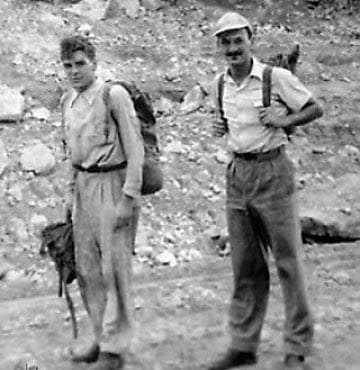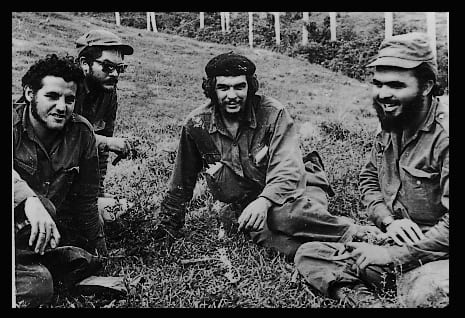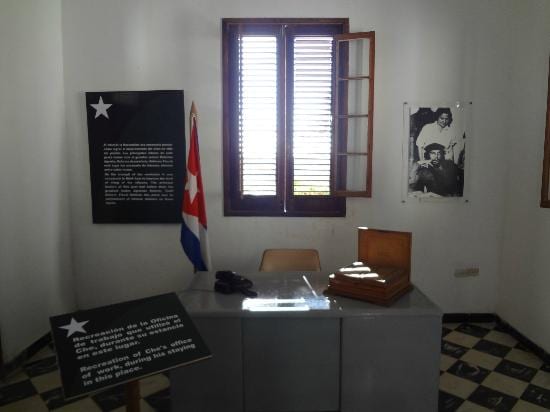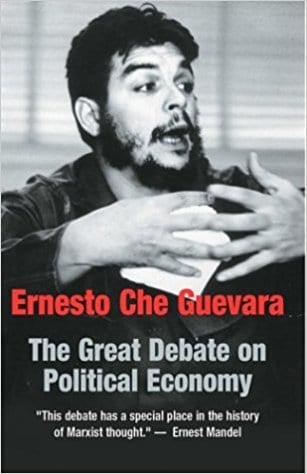Book Review: The Politics of Che Guevara: Theory and Practice
“For many rebellious young people throughout the world, Che Guevara is seen as a key leader of the Cuban Revolution…and the only one who coherently practiced what he preached. Even more appealing to many are Che’s personal values: political honesty, egalitarianism, radicalism, and willingness to sacrifice for a cause, including his position of power in Cuba. To many of the contemporary rebels active in anticapitalist movements, Che is not only a radical, uncompromising opponent of capitalism, but…also a revolutionary who shares their own ideals in pursuit of revolutionary and antibureaucratic politics. This is what makes Che’s ideas and practices important, and this study relevant, in today’s world.” (Introduction, xvi-xvii)
By Sheyla Hirshon
 HAVANA TIMES — This slim, 120 page volume entitled The politics of Che Guevara: theory and practice by Samuel Farber* has been sitting beside me on the desk for some time – Che’s familiar implacable gaze staring out at me from the cover illustration. The inevitable question has been haunting me: Why pick up another book about Che Guevara? It now joins with other urgent questions: What did the left do or not do to bring us to the current dark juncture? Could Cuba’s revolution have developed differently, and what would that have meant for world history? What vision does Che still have to offer?
HAVANA TIMES — This slim, 120 page volume entitled The politics of Che Guevara: theory and practice by Samuel Farber* has been sitting beside me on the desk for some time – Che’s familiar implacable gaze staring out at me from the cover illustration. The inevitable question has been haunting me: Why pick up another book about Che Guevara? It now joins with other urgent questions: What did the left do or not do to bring us to the current dark juncture? Could Cuba’s revolution have developed differently, and what would that have meant for world history? What vision does Che still have to offer?
It’s 2017 and the planet seems to have darkened for those of us who believe in a kinder, more just world. Yet Che’s image persists: that black portrait on a red flag, evoking resistance, commitment, strength of purpose, kindness, even sorrowful knowledge of the price paid for victory, hope in the future. He has become a figure so soaked in our own mythologies as to become nearly unrecognizable.
As the world embraces ideologies I thought long buried by history, I feel the need to look back on ideals and heroes I once was so sure of: was it their ideas or their flawed application of these ideas that led to the present disasters?
And so I pick this book up again.
I have previously found Samuel Farber an excellent teacher: learned, thorough and thoughtful, he expresses his ideas clearly and accessibly, documents them completely, and discloses his own opinions with full awareness that they will inevitably color his conclusions. Hence, I picked up his recent book with every expectation of finding clarity and perspective with sometimes an uncomfortable jolt to my preconceptions.
I was not disappointed. In essence, his case is this: The difficulties that have engulfed Cuba are not fundamentally products of the blockade or of U.S. hostility although the latter imposed “serious external and internal constraints”. Rather, they are the outgrowth of choices made by the early leaders, specifically Che and the Castro brothers, to shape Cuba into a top-down one-party system where worker and citizen participation is restricted to assent and obedience.
Farber looks squarely at Che’s role in all this. “The purpose of this project is to present a political portrait focused on Guevara’s thought and practical politics and the varying situations in which he acted, and in the process help to dispel many of the common myths about Che.” (xxv-xxvi) He builds his thesis by examining Guevara’s writing, speeches and deeds, generally relying on primary sources.
The book divides into four substantive chapters: “The Bohemian Origins of Che Guevara’s Politics”, “Che Guevara’s Revolutionary Politics: Ideas and Practices”, “Che Guevara in Power” and “Che Guevara’s Political Economy”. There’s a very helpful chronology at the beginning, but the book itself evolves thematically, cycling back in some cases to look at the same time period through a different lens.

Farber begins with Ernesto Guevara’s pre-Cuba years. Some of the background details are familiar: the influence of his mother and of his asthma in the formation of a voracious reader and independent thinker; his decision to set off on across South America; the impact of his witnessing the CIA-backed overthrow of Guatemala’s democratically elected president Jacobo Arbenz in 1954; and his fateful encounter with the young Fidel Castro and the Cuban exiles in Mexico.
Farber also adds some less familiar background elements. “His mother, Celia de la Serna, dedicated to the cult of creativity, would bring home all kinds of colorful people from a wide variety of social backgrounds, from itinerant painters who worked at bootblacks to wandering foreign poets and university professors who stayed to any length of time…Celia also encouraged her children to lead completely unstructured and disordered lives and to develop friendships with children of all social classes”(p. 2). Yet, because of both parents’ secure place in the Argentinean social milieu, the family status would never really be called into question. Nor was the family politically involved.
With this background, the 25-year-old Che – contemptuous of formality, extremely well-read and with a combative intellect – departs Argentina in 1953. Despite a degree in medicine, he was still describing himself as “100% adventurer”. His subsequent experiences would mold the committed Che of the banners and history books; yet Farber argues that these early experiences did color his thought in a number of ways.
“Many of the ideas and actions that characterized Che Guevara’s political life are traceable to his personal history of growing up in a privileged milieu in the prosperous Argentina in the first half of the 20th century. Prominent among these were his emphasis on egalitarianism and opposition to privilege; the advocacy of individual sacrifice for the sake of collective goals conceived in distinctive ascetic terms; a profound voluntarism – the idea that human will and consciousness can by itself overcome any objective, material obstacles and a political tone-deafness that failed to recognize the specificity of political situations and conjunctures” (p 11-12.)
The three following chapters go on to describe Che’s revolutionary politics, his actions while in power, and his writings on political economy. They return to these threads, in increasing juxtaposition to the tactics and beliefs of Fidel and Raul Castro.

Farber traces the evolution of Guevara’s “idiosyncratic communism” from his early contacts with the Guatemalan left. He chronicles the tactical conflicts that arose during the two-year guerilla struggle in Cuba, and Che’s evolving relationship with the PSP (Partido Socialista Popular, the traditional Cuban pro-Marxist party) during the guerilla struggle and beyond. He also devotes space to the areas in which he coincided and differed with the orthodox line of the Soviet Union, and with the Castro brothers.
As time went on, Che would come to view guerilla warfare based on the struggle of the peasant masses as the one path to international revolution. The book “Guerilla Warfare” that he published in 1960 outlines his theory of guerilla strategy and the conditions to conduct this kind of struggle. Che would also eventually conclude that it was the best way that he, himself, could contribute.
Farber sees the growing U.S. hostility as a factor in this: “When Guevara wrote “Guerilla Warfare”, Fidel Castro had not yet declared the “socialist” character of the revolution, nor had the US-sponsored invasion of Cuba in April 1961 and missile crisis of October 1962 yet taken place. The diplomatic relations of all Latin American countries with Cuba had not yet evaporated under Washington’s pressure. The serious economic crisis that began to affect the island in the early 1960s, partly as a result of the US economic blockade, had not yet happened either. But as all these events began to take place, they created a certain degree of anxiety and urgency, and even a sense of political despair that made them, Guevara included, want to fight anywhere, regardless of the circumstances.”(p. 38)
Two core convictions shaped Che’s view of guerilla struggle: 1) that the peasantry, not the organized working class, was the motor force; and 2) that a small vanguard should lead and the people will follow. This recipe would lead Guevara to the disastrous Congo mission of 1965. Later, although he himself wrote about the mission in a pamphlet entitled “The History of a Failure,’” he would go on to his last, fatal expedition to Bolivia with his core convictions unchanged.
In “Che Guevara in Power”, Farber returns to the first years of the Cuban revolution. He chronicles Che’s actions in his successive roles as head of the military installation at La Cabaña”, head of the Industrial Department of the National Institute of Agrarian Reform, President of the National Bank, and Minister of Industry, all in the space of the first several years – from 1959-1965. Farber outlines “his hard, Communist views regarding ‘bourgeois freedoms’ far from the ‘humanist’ philosophy attributed to him”(p. 72). His most finished written work, Socialism and Man in Cuba, lays out his vision of the New Man: selfless, idealistic, and heroic, ready to sacrifice for the common good. While certainly an inspiring ascetic ideal, Farber feels that it resulted in an increasing exploitation of Cuba’s workers, serving to suppress rather than satisfy the material needs of Cubans.

Meanwhile, Che also defended a party made up of a small cadre, until such time as “the masses have attained the level of development of the vanguard,[1]” although he doesn’t outline when and how this might happen. In May 1960 he was among the key leaders who helped establish a politically monolithic mass media system that continues to exist even today.
Even the oft-quoted statement about love is debunked here, as Farber notes: “a few lines [after this phrase] he says: ‘Our vanguard revolutionaries must idealize their love for the people…they cannot descend with small doses of daily affection, to the places where ordinary men put their love in practice.’”[2]
Che’s ideas on political economy, as described in the final chapter, were well aligned with what Farber terms: “orthodox politics with a third world inflection.” The book covers Cuba’s “great debate” about the economy from 1963 to 65, a debate of which average Cubans were unaware. Che was an unflinching supporter of moral vs. material incentives, a centralized budgetary system of financing, and need to alter the application of the law of value. History, of course, has not vindicated him here, nor has Cuba followed his lead.
Farber avoids judgment, but several themes are pointed out time and again. One is what he has termed Che’s “political tone deafness”, an excessive reliance on ideals or principles rather than concrete circumstances when making decisions. He contrasts this with the role and strengths of the tactically shrewd and organizationally gifted Castro brothers. He concludes, however, “Notwithstanding the differences Guevara had with the Castro brothers and the Cuban pro-Moscow Communists, he shared with them, until the very end, the same project to overthrow capitalism and build a new socialist society. This shared project was based on the creation of a new class system based on state collectivism, a property form in which the state owns and controls the economy and a central political bureaucracy ‘owns’ the state”(p. 119).
As a straightforward academic venture documenting Che Guevara’s thought from primary sources, The Politics of Che Guevara is a satisfying and accessible book with a lot of thought-provoking history and analysis. It left me with a clearer picture of events I was broadly familiar with, if occasionally dismayed at the dismantling of my own illusions.
 However, as I mentioned in the beginning, the topic and the times push us beyond the mere academic and the book goes beyond documentation. Perhaps Farber – like myself and other HT readers – was plagued with speculations that lead beyond the terrain of historical objectivity: Would Cuba’s (and our own) history have been different if Che had thought differently? And – What would the better path have looked like?
However, as I mentioned in the beginning, the topic and the times push us beyond the mere academic and the book goes beyond documentation. Perhaps Farber – like myself and other HT readers – was plagued with speculations that lead beyond the terrain of historical objectivity: Would Cuba’s (and our own) history have been different if Che had thought differently? And – What would the better path have looked like?
His response to such interrogatives runs through the book like a kind of counterpoint melody in a piece of music, beginning forthrightly in the introduction: “Central to my perspective is a view of socialist democracy in which institutions based on majority rule control the principal sources of economic, social, and political power at the local and national levels” (xvii). This almost wistful alternative theme follows the text, sometimes barely perceptible in a few sentences, then at times rising up above the main melody for a few paragraphs before sinking back, and finally coming into its own in the conclusion.
The book concludes with a “Coda” declaring the inevitability of revolution because “even the most welcome, authentic reforms cannot bring about more emancipation and liberation.” (p.120) and Farber’s declaration that such a revolution can only come to fruition through a process that brings together socialism, democracy and revolution.
As a reader, I ended up with two minds about this counterpoint. On the one hand, Farber himself is abundantly clear that democratic participation was never a part of Che’s politics, and at times the added thoughts on what might have been seemed a departure from the thesis. On the other, though, Che has simply loomed too large in our ideals and aspirations to simply note the space between the myth and his actual words and deeds.
So rather than a distraction, the places where Faber points out missed opportunities to build on the Cuban workers’ struggle, or speaks of the relevance of civil liberties in the context of a social revolution in a less developed country lifted the book out of the merely historical to address those burning questions that brought me to open it at all. In the end, as our vision of Che evolves from hero-worship to sober reality, this counterpoint melody is the one I was most grateful to listen to, carrying as it does a faint, possibly wistful, note of hope.
—–
*Farber, Samuel, The Politics of Che Guevara: Theory and Practice, Haymarket Books, Chicago, Ill. 2016.
[1] Ernesto Che Guevara, Socialism and Man in Cuba, in Bonachea and Valdésm “Che: Selected Works of Ernesto Guevara, 166-7. As quoted on p. 80.
[2] As quoted in “The Politics of Che Guevara”, p. 82.






The topic is Che Guevara
in my comment I have talked about the evil that controls humanity which embodies itself in the new world order , in which you have neglected to comment on , Someone in the statue of Che Guevara embodies the ultimate human sacrifice , he sacrificed himself for the sake of other human beings that he have never met neither had the chance to meat , Che Guevara his name and good deeds would be mentioned until the end of time , he was willing to fight the ultimate Evil that controls Humanity which is coming to us in the form of the New World Order , wake up Humanity there’s isn’t a hole much time left ,
What a perfect post, Nidal. It certainly clarifies where you are coming from. I have had the pleasure of meeting Paul Hellyer several years ago and I can confirm he is certifiably, paranoid, buggy-eyed, “the aliens have take over the US government” insane. It makes sense you could write “Che is one step before a prophet”
You & Paul are two peas in a (alien) pod.
Che Guevara ,
In the last 130 years of human history , Che Guevara would be the only human being who achieved a level of respect like no other , he is practically One Step before a prophet , with no doubt he was a visionary able to see what a whole lot of people around him could not see ,
Humanity needs a hero like him to come out of nowhere on a white horse and slay the Dragon the same way as Saint George, the Dragon that’s and George have slayed is the dragon of greed he had the princess and the gold at the same time he could use neither ,
What I am about to say may be shocking to some of you , it’s going to sound way off the topic , except it is in the heart of the topic the topic of selfless sacrifice in the name of our fellow human being and make sure that human freedom precious human freedom is Supreme ,
Please bear with me for a minute and allow me to explain when I’m trying to get to .
There is an evil unleashed on Humanity like no other , controlled by a cabal, evil cabal evil beyond any imagination , in consists of the 1% that controls the 1% that controls the rest of humanity , totally ruthless in their quest to control Humanity , they are behind the creation of one enemy after another , one terrorist after another , they have practically financed terrorism for the last 400 years if not more , please listen to the following YouTube clip from
Ex Defense Minister Of Canada
Paul Hellyer
Watch “Disturbing Message To All Americans From Ex Defense Minister Of Canada” on YouTube
https://youtu.be/IWfKfuuj6Jo
President eisenhower warned us of the military infrastructure ,
https://youtu.be/fijEdXPYYeA
The German scientist Wernher von Braun warned us about what’s going to happen next ,
Dr Carol Rosin in the next video clip will do a much better job in explaining what Wernher von Braun had to say then anyone else I could think of ,
https://youtu.be/CR4-peqljnk
Basically there is an evil cabal trying to control the world and they are behind just about every kind of terrorist out there in order to subdue Humanity under their control they call it the
New World Order